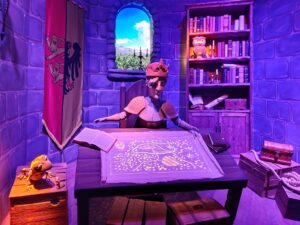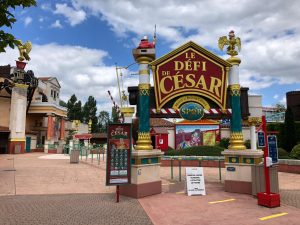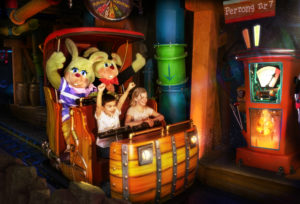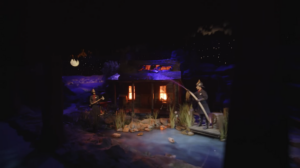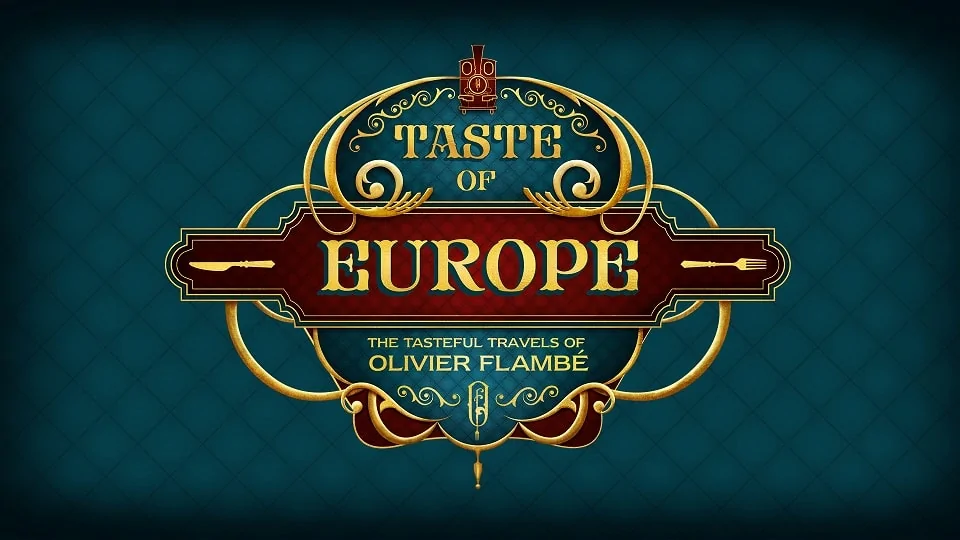
On March 2nd of this year, Storyland Studios launched a design contest for freelance theme park designers, the Storyland Studios Design Challenge. For the design challenge, Storyland Studios asked participants to plan a new story-based attraction. With a grand prize of $20,000 and the fame of winning, it attracted 78 individuals and teams that wanted to take a shot. Among some great concepts and designs, a team from the Netherlands created the winning design, titled “Taste of Europe – The Tasteful Travels of Olivier Flambé’. We sat down with the winning design team to talk about the contest and how they created their prize-winning concept.
Storyland Studios is a design company from Elsinore, CA – United States. The company has created designs for theme parks, retail stores, restaurants and cultural attractions. Their work has been seen across major clients such as Universal Studios, Warner Bros. and Merlin Entertainment. The company announced their design challenge with their partner Blooloop on the 2nd of March, 2021.
Each participant in the contest was asked to create a design for an attraction that would be evaluated on six criteria: depth and richness of storytelling, emotional resonance, design innovation, creative use of materials, executability and ecological compatibility.
Within these six criteria, designers had all the freedom to design the ride of their dreams. A jury of six renowned members of the theme park industries voted ‘Taste of Europe – The Tasteful Travels of Olivier Flambé’ as the best.
The winning design
The design for Taste of Europe was created by a team of five designers from The Netherlands: Nicky de Waal, Wim Strijbosch, Tim Beeren, Mark van Rooij and Vincent Keuchen. The story of the ride takes place in Paris in the year 1900 and is set around the character of Olivier Flambé. Flambé is a friendly cook who has inherited his family’s bistro in Paris. He is a great chef, but wants to try something new. His employees, however, want to stick to the old family’s recipes that have been served in the restaurant for many years. That is why Olivier Flambé needs help.
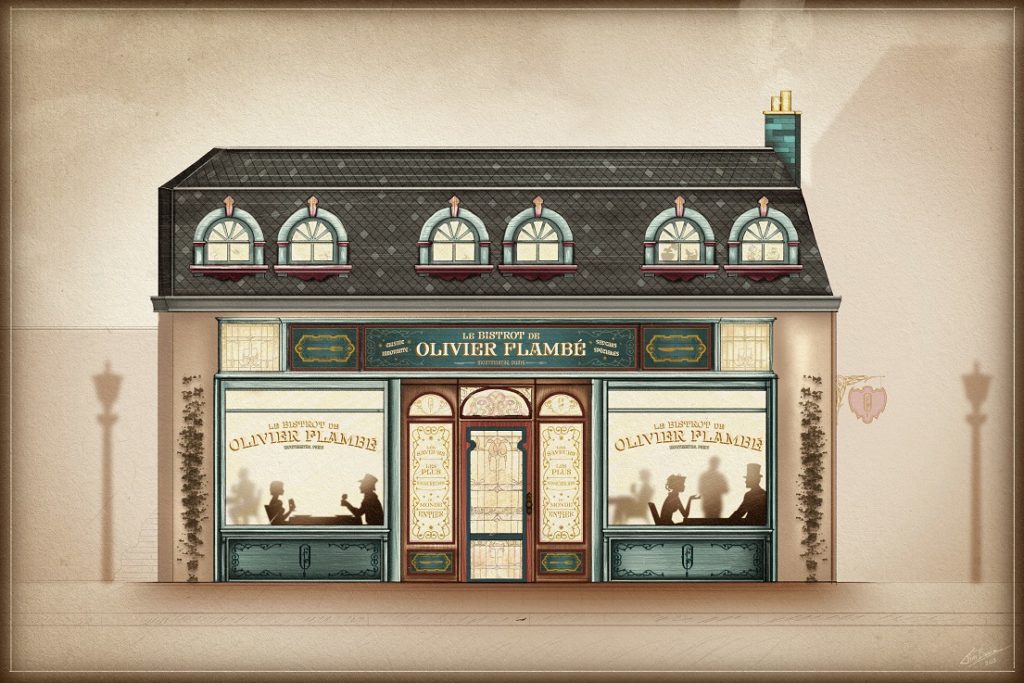
Visitors enter the attraction through ‘Le Bistrot de Olivier Flambé’, which resembles a typical turn-of-the-century French bistro from the 18th arrondissement of Montmartre. The queue line leads through the back of the restaurant, from the freezer through the kitchen. They are led into a storage room with a pre-show. The room is messy and contains several items from the restaurant. There is something that catches the eye of the visitors, though: a large curtain. There is something underneath that curtain. Suddenly, Olivier’s voice can be heard through a speaker. He explains that he has made a new invention that will change the way of cooking forever. He calls his invention the FusionCuisine XL 1900 and at the same time, the curtain is lifted to show his invention to the audience.
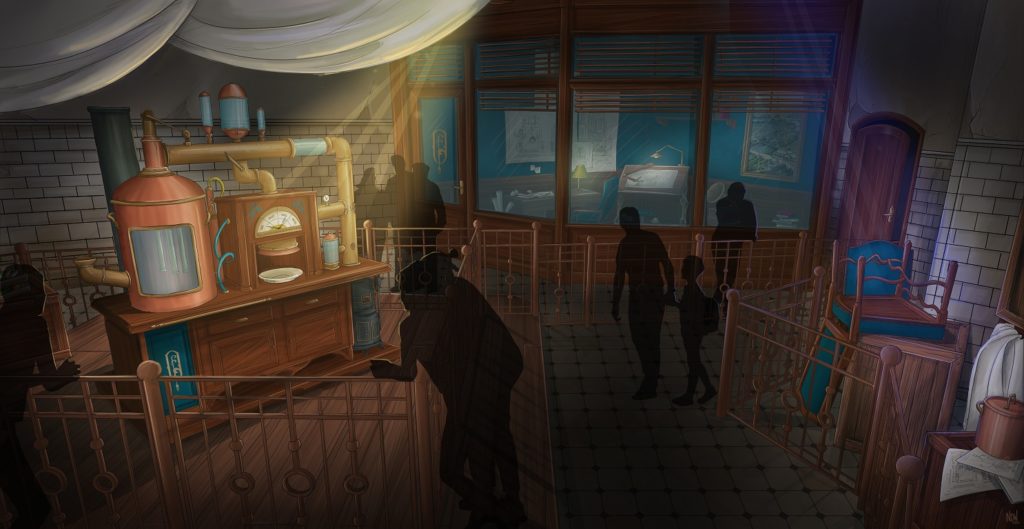
The FusionCuisine XL 1900 is able to combine tastes from all over the world. Olivier wants to present his invention during the Paris World Fair of 1900, which starts soon, but he is still short of a few ingredients. Visitors are asked to travel across Europe to retrieve the final ingredients from both Budapest and Venice and return as quickly as possible to finish the FusionCuisine XL 1900. Through a secret passage, visitors are led towards the Gare d’Orsay train station in Paris, where they can board the Orient Express to Budapest.
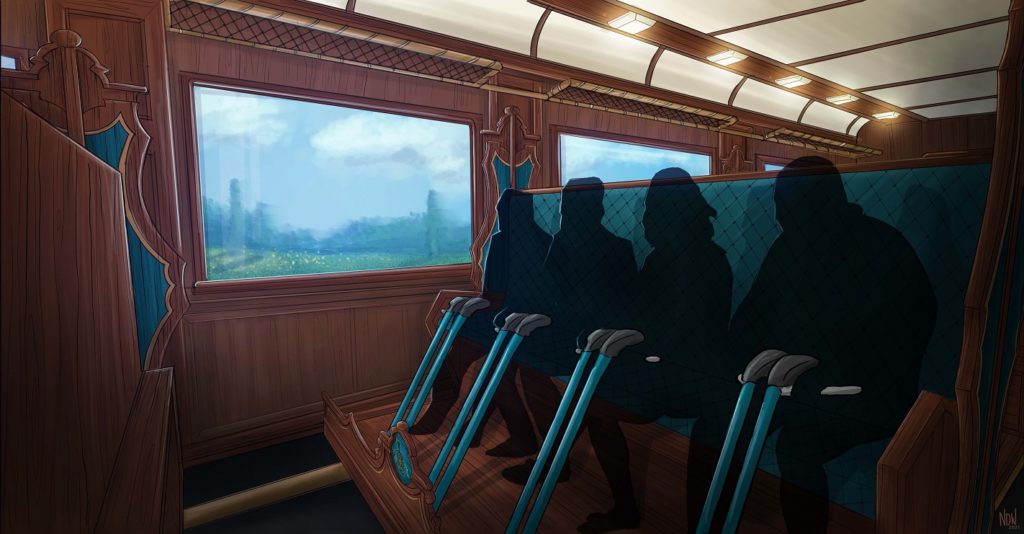
Visitors will board ride vehicles that completely match the style of the Orient Express and start to make their way to Budapest. The journey leads them on a scenic tour through the French landscape, lower mountains of Germany and Austria and eventually to the station of Budapest.
After arriving at Budapest station, the visitors will exit their vehicles. A walkthrough will follow, leading the visitors through the streets of Hungary’s capital. The narrow streets are filled with cafés and food stalls, so that the visitors can collect the tastes for Olivier’s invention. While walking through the streets, the city slowly evolves into the iconic city of Venice, where visitors can collect Italian ingredients.
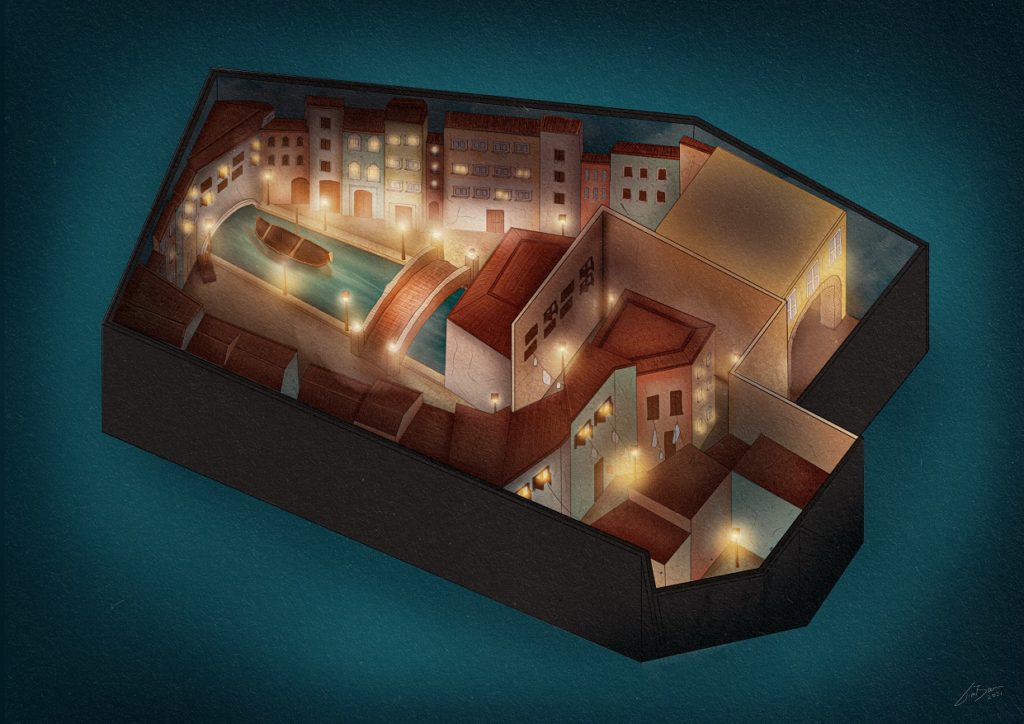
Visitors will board the Orient Express again in the station of Venice and travel back to Paris to make it in time for the World’s Fair of 1900. However, something does not go according to plan: The train is switched onto a track that was still under construction. The train derails somewhere in the Alps, which causes the ride vehicles to fly over the mountains. The scenic trip to Budapest had changed into a thrilling roller coaster-like experience. Eventually all vehicles find their way back towards Paris and return to Gare d’Orsay.

Visitors will exit the ride through the restaurant of Olivier Flambé. This time, not his bistro, but his restaurant on the Expo. The restaurant is larger than the bistro and completely in Beaux-Arts style of the 1900 Expo Universelle architecture, with an iron structure and large glass roof. Right in the center, we can find the FusionCuisine XL 1900 in action, it is connected to the kitchen where the dishes are prepared. The visitors have succeeded in helping Olivier Flambé to make the FusionCuisine XL 1900 steal the show at the World Expo.
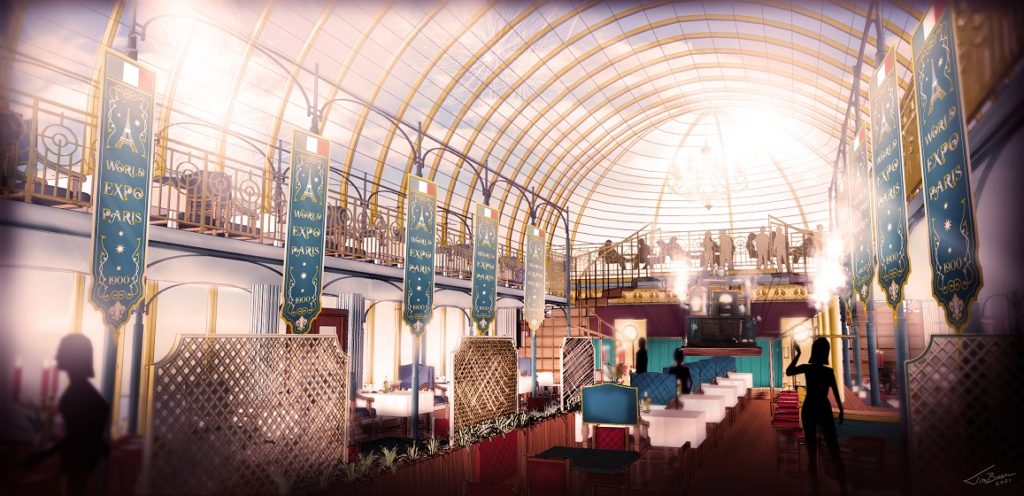
Taste of Europe – The Tasteful Travels of Olivier Flambé is an elaborate concept that was designed in a very short period of time. We spoke with Wim, Mark and Vincent of the design team, about their experience with the contest and of course about the creation of their winning design.
Assembling the team

Can everyone introduce themselves in short: who are you, what do you do in daily life and what were your tasks within the team?
Vincent: I am Vincent Keuchen, 34 years old and I am an illustrator and designer. I work all over the place and I simply have one mission – to make the world a clearer and more attractive place with my designs. I love to bring fun and clarity into complex worlds with stuff like signage, maps, infographics, murals, editorial and live illustrations. I work for a broad variety of clients and industries, which in my opinion often helps to bring in new perspectives neither being biased to just do the stuff that is being done within the boundaries of an industry.
Ever since I was a kid, I have been fascinated with theme parks – so I guess it is no surprise that I ended up doing work for clients within the leisure industry as well. I create a lot of designs for the Norwegian theme park Kongeparken and the Swedish Zoo Skånes Djurpark, both part of the Lund Gruppen family. I started working as a freelancer about five years ago and already then I knew Mark, with whom I have worked a lot together on projects for his company Kinetic Creative. It was a no-brainer for me when he called me earlier this year to take part in this project together. I have helped to come up with the concept, which we did as a team. After that, I was responsible for illustrating the ride course and character design.
Wim: My name is Wim Strijbosch and I am 29 years old. I work at Breda University of Applied Sciences, where I am currently performing my PhD research on the impact of emotion during leisure experiences. Emotions are said to be the key that makes an experience memorable. I am investigating whether this is true and how this key works. Do you need to turn the key left or right for emotions to work; that kind of stuff. In particular, I am trying to investigate the relation between emotion and how people remember experiences in the leisure and tourism industry.
Before I started doing this, I worked in the design department of Toverland. I did not really design something new myself, but created detailed drawings for suppliers based on designs by other members of the design team. Over the years, I found out that drawing and designing was not my strongest skill, but I did find out that I really enjoyed doing research. For Taste of Europe, I was overseeing the design, making sure that we did not get lost in details and the total picture was still correct. And in a later stage, I was in charge of all presentation texts.
Mark: I am Mark van Rooij, 34 years old and for about five years now I am a designer/concept developer at Kinetic Creative. We design concepts for (public) playgrounds, waterparks and visitor attractions. In addition, I work at the company Swedice in the role of product developer and designer. Swedice is a developer of ice rink systems and winter attractions. We developed some ideas for Efteling’s winter season, the ice skating rink in Amsterdam, Copenhill in Copenhagen and Riyadh Seasons.
For Taste of Europe, I have been making sure that we would come up with something unique and I was in charge of the design of the ride system. Making sure that this was unique, but made sense within the style and story of our ride.
Two members of your team could not be here today. Who are they and what did they do for the project?
Wim: Nicky de Waal did the art direction. She made artist impressions and detailed drawings of the scenes. Tim Beeren was in charge of the graphic design. He created the style of the ride, logo and the graphic design of the presentation booklet, as well as some artist impressions.
So Storyland Studios is promoting a contest that they are organizing. When did you decide to enter the contest and how did the team get together?
Mark: That is a funny story. I saw the announcement on Instagram and I thought it would be nice to participate. I reached out to Wim and Vincent, but we wanted another designer. Wim suggested Nicky, but she said she was already talking with Tim to participate. I suggested merging the teams so that we could have all the expertise in one team: a schematic designer, a concept developer, a graphic designer, an illustrator and a scientific researcher.
Vincent: And most of all, all people that love the leisure industry.
Wim: It remained silent for a long time, but eventually there was a sign-up deadline. You had to pay money to sign up after that date. That is when we decided to sign up and that is when we started.
From scratch to sketch
Pre-registration for the contest started on the same day as it was announced (March 2nd) with an official opening on April 5th. The deadline for the contest was set for the 4th of June, just three months after the start of the contest.
Now you have a team and you are going for it. What was your starting point? What were the early ideas and how did you get to Taste of Europe?
Wim: We used the philosophy of Ton van de Ven (designer for Efteling, the major theme park in The Netherlands, who designed Fata Morgana, Droomvlucht and Villa Volta) as a starting point. When he was asked how he was able to create rides that were so loved by the large audience of Efteling, he answered: “I use the saying that the masses consist of one more than you think and that is you.” (Thesis “De Efteling als ‘Verteller’ van Sprookjes” by M.E.J. Hover). Just like Ton van de Ven, we are also part of the theme park audience. We decided to look at things that we liked and we thought would be original. Every team member came up with a couple of ideas, which we pitched to each other. We created a diagram to group these ideas and combine them and saw that a couple of themes popped up multiple times. Traveling, turn of the century, World Expo, story book and fairy tales where themes that multiple people had on their list.
Mark: From those themes, we always got back on traveling and inventions. Mostly the pleasure of traveling and exploring. That overlapped in all kinds of themes. In an early stage, we had one idea for a walkthrough on a ship, one of the cruise lines from Antwerp to the United States. You would board the ship in Antwerp, have dinner and experience a complete walkthrough on that ship. However, we asked ourselves where we could place such a ride. You cannot have dinner during all opening hours of a theme park, as they are mostly open during the day and not the evening. We stepped away from the dinner experience, but kept the food theme.
Vincent: The ride and dinner idea was chaos. It was a nice idea, but we could not combine the two in an orderly way. We tried to work it out by drawing maps, but we could not get it right.
Mark: Eventually we had some idea that would suit a park like EPCOT. Our ride had two different entrances and exits. You could enter the ride in Italy and leave it in England or the other way around. We moved on from that idea, but wanted to keep something with a transition to another culture.
Vincent: I remember that as a fun meeting with all of us just trying to work things out.
Wim: Yes, but it also gave me headaches. Changing one thing, finding out that this was not possible, changing it back. Looking back at that meeting, it was fun, but when we sat there it felt like chaos.
Mark: What bothered me during that meeting was that we had all sorts of ideas, but could not find a way to combine them all. We eventually landed on a concept that had all of the ideas. It turned out to be a boat ride with a narrative that had a start, middle and end. Perhaps an original theme, but it was not innovative at all anymore. We felt that if we entered this concept, we would lose the contest. So we completely started over. We created a new diagram, but kept the transition idea. We wanted visitors to get off the ride somewhere. You get on the ride in Paris (France), travel with the train across Europe and get off the train in Budapest (Hungary). That is where we would place a walkthrough to Venice (Italy), where people would board the trains again to go back to Paris with a wild ride through the Alps.
Wim: With that idea, we also wanted to combine the World Expo (Paris 1900). We thought about doing some sort of race like in ‘Around the World in 80 Days’. But we did not want a race against someone else, but perhaps against time. We came up with an inventor that wants to present his invention at the Expo, which, in our story, is tomorrow. However, the invention is not finished yet and you will need to help him in a race against time. There have been a lot of steps to get to this concept, but eventually we were all enthusiastic about it.
Vincent: Sometimes we only took a part of an idea and left another part out of it. You would sometimes feel disappointed by that. It would feel like something incomplete, but when you thought about it and looked at it in the right way, you just knew that this was the way to go.
Mark: It was also kind of nice to have a deadline. We had to move on to the next step, otherwise we could not make the deadline or have an unfinished presentation. After we made the decision on what our concept was going to be, we had three weeks left to make the designs. We were able to make a clear document where we could describe our concept in detail. This could not be done without a good schedule and sticking to our own deadlines.
Wim: Yes, every once in a while we just had to make a decision and after it was made, we could not go back to that any more.
Mark: You can actually make an original design with every theme. But once you decide on the theme, your main goal should be to try and make your concept as strong as possible.
All ideas that could be combined were eventually combined. How did you add everything together?
Wim: The basic idea was there: inventor, traveling and the world expo. That is when my teammates said ‘Wim, you have not done a lot yet, you put the ideas on paper’. From that moment, I started to write the story of our ride, based on the themes and ideas we discussed. Good thing that we had all kinds of ideas and that made it easy to finetune those in the story. We cut the story in five pieces. Everyone had to create a storyboard for a part. Not with detailed graphics, but just to show what would happen from the beginning of the ride to the end of the ride. This way, we could see what shape the ride would get. We could see rooms, check the actions. Having this storyboard made it easy to discuss things. It was not just an idea in our minds anymore. We could add or scrap things. Eventually everyone felt that this was going to be our ride. That is when we decided that this would be our storyboard and that this was what it was going to be. One of our ‘take the plunge’-moments.
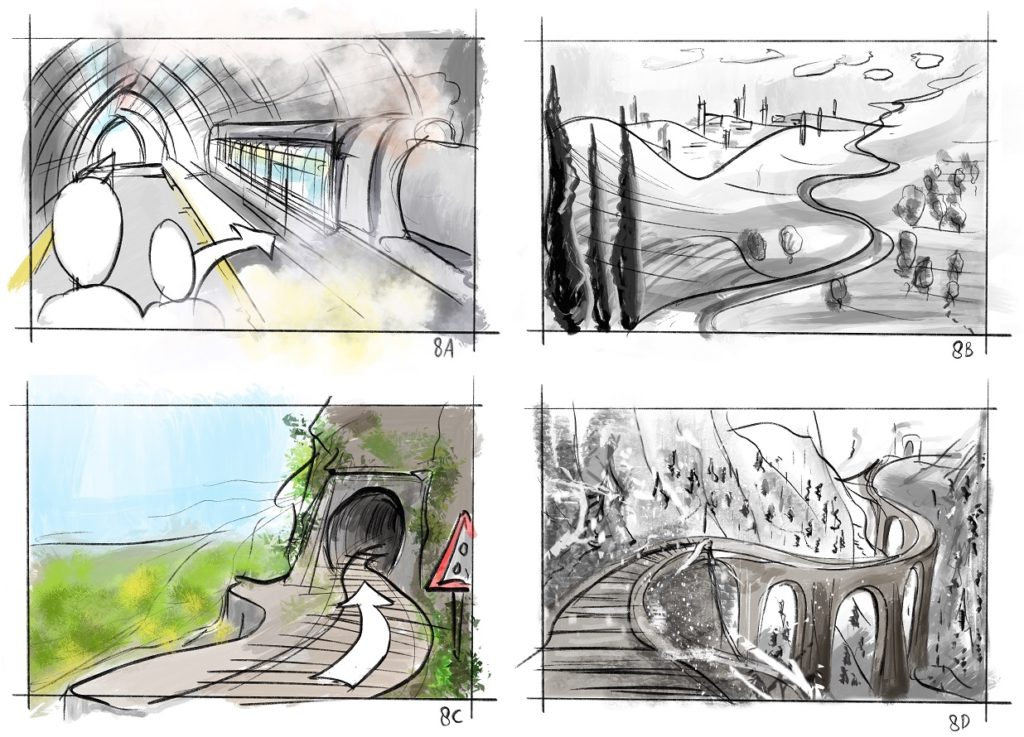
Wim: These decision-moments were very important and came in very useful. We all worked on our own discipline. By having these strategic decisions for the theme, story and storyboard, we always knew what we could expect from each other, because we had already made them.
Vincent: It also came in handy when we made decisions on what we wanted to highlight in our presentation, because we did not have to make detailed drawings of each scene.
Mark: We started to combine parts of the storyboard that could take place in the same scene. We ended up with 12 scenes and because of the storyboard, we knew whether a scene would be small or large. I converted the scenes into a building. We estimated a ride time of eight minutes. We started to look at other dark rides with this ride length and found Pirates of the Caribbean, Mystic Manor, Haunted Mansion. I started measuring these buildings. The result was an average of 60 by 80 meters. We created a 3D model of the building. I made renders of the individual rooms and sent them around.
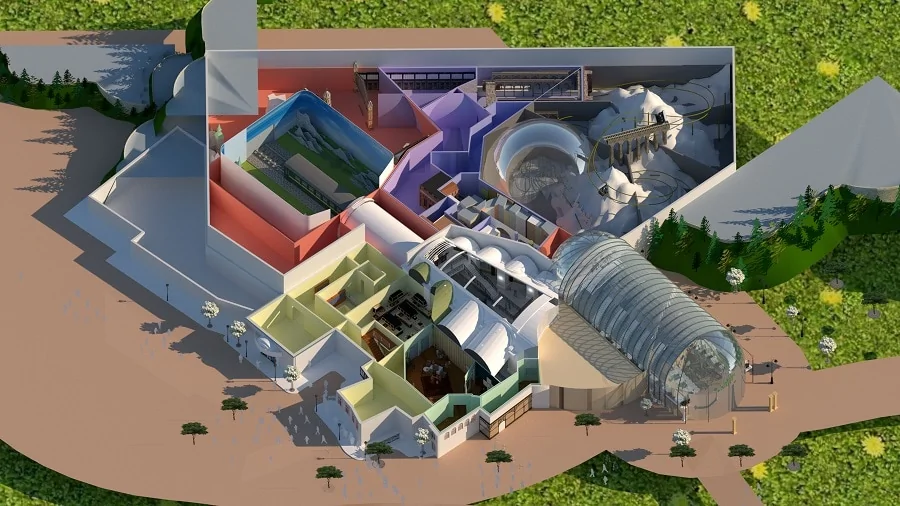
Did you also decide on the spaces of the scenes in that masterplan?
Vincent: Yes, that gave us the idea of that immersive tunnel scene. The scene we had in mind would take more space than we had. We solved this by creating moving scenery in a loop. We did not want audiovisual screens, but wanted physical sets in there.
Wim: That is something we decided from the beginning. We did not want a screen-based ride.
The specific scene makes use of a parallax effect. The ride vehicles will slowly move forward through the scene. By having multiple loops of moving scenery, the parallax effect creates a feeling of moving faster through a larger scene.

Mark: Eventually we went into detail. I sent some signs and advertisements to Tim and he created the visuals and logos for it. And Vincent created the character.
Vincent: Yes. The character became this chef that liked to invent some new kinds of food in his own free time. An older, bit absent-minded. I envisioned Belle’s father from Beauty and the Beast. Also a bit crazy, but also smart enough to come up with something cool. We had not made a decision yet on when we would introduce him. We thought about an animatronic in the queue line, but did not do that after all.
All aboard – Designing the ride system
For Taste of Europe, you designed your own unique ride system. How was that conceived?
Vincent: At first, we did not really look at a certain ride system, but we focused on the story we wanted to tell. Later we looked at what ride system suited best. When we could not find one, we decided to design our own ride system for this.
Mark: We thought about riding, flying and sailing but we felt that a train ride would be most suitable. However, we still had that transition moment in the middle. Stopping at a station and continuing later. I really liked the idea of the first part riding a train and the second part flying over the mountains. Two separate ride systems would be expensive, complicated and not doable. But we still wanted to keep that flying-sequence in the ride. The first part of the ride is a panoramic view. The second part goes into the Alps and speeds up. We wanted to derail the train and let the cars fly over the mountains. That was when we started to think about a way to make the cars fly.
We used two inspiration sources for that. First was the pipeline coaster of Togo. Second was a transportation system by WGH Transportation Engineering. They had a suspended car ride system with some sort of pendulum that lowers the cars. I saw that in the Shipyard Ride at the Titanic Experience in Belfast. That looked really interesting.

The design team has named their ride system the ‘SideRail System’. It consists of cars with one row of four seats. The vehicle will be connected to rails on both sides with a wheelset. This wheelset can actually move on the side of the vehicle in a vertical direction. This way, the vehicle can make a transition from a driving mode to a suspended ‘roller coaster’-mode.
For the first part of the ride, riders would have to feel like they are on the Orient Express. These vehicles obviously do not resemble a train carriage. Therefore, the design team added several moving set pieces around the track that will give riders the feeling they are in a train carriage. These set pieces will move from tunnel to tunnel that are conveniently located between each scene.
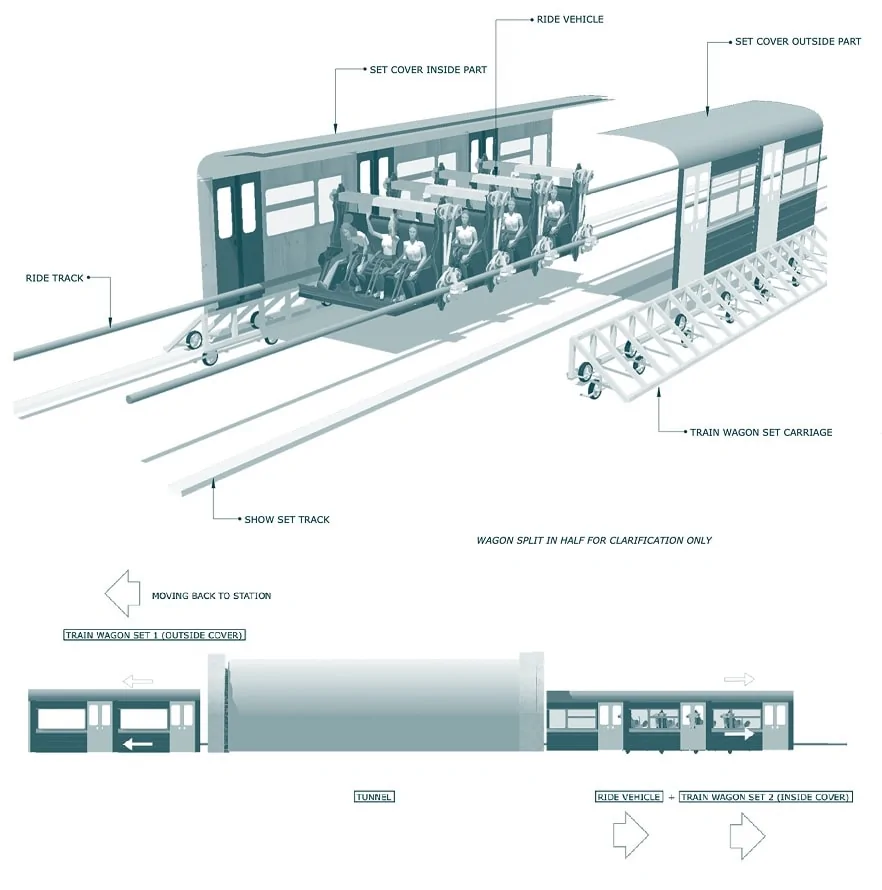
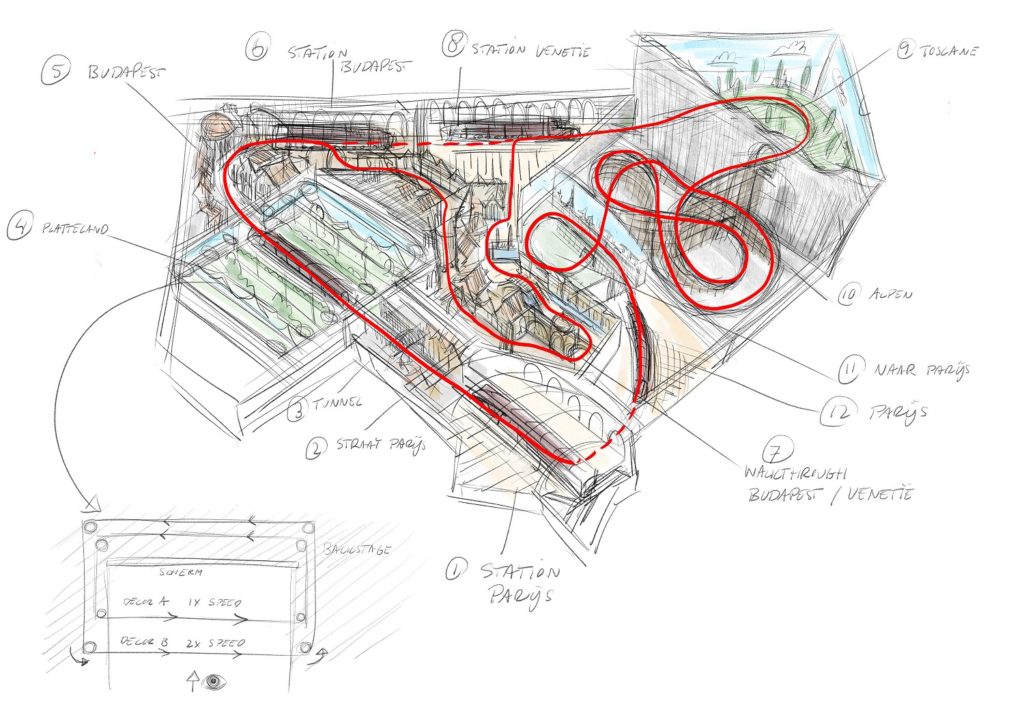
Did you ever think about a place where Taste of Europe could actually be realized?
Mark: When you look at theme parks in Europe, you will only find about five theme parks that can afford this ride. We thought about having it as a standalone ride in a tourist or entertainment area.
Vincent: We imagined it could be an experience in places such as Amsterdam or Las Vegas. We thought about how to create a larger return on investments by offering arrangements that includes dinner.
Mark: It might even work as an evening-attraction for Europa Park in their resort between their hotels and bars.
Vincent: We spoke with Pieter Cornelis (a well-known Dutch theme park economist) about this, because we did not have enough knowledge on this subject. If we received any questions by the jury, we wanted to give them the right answers. He gave us insight on how much money you had to make to make a profit.
Wim: We estimated and calculated the throughput of the ride and restaurant and we came to the conclusion that it would work in one of the five big parks in Europe, or as standalone in an entertainment area. This ride would be perfect for a theme park that has an established reputation. This ride would be perfect for a park where you have a steady amount of visitors to have a ‘temporary growth investment’. This ride is not suitable for theme parks that are still growing to their potential. That leaves only a select number of theme parks. As a standalone ride, you will need to place it somewhere that people already visit.
Results of the contest
Storyland Studios had arranged some great partners to judge the contest. The jury consisted of six renown people from different aspects of the theme park industry: Doris Hardoon (Executive Creative Director for Storyland Studios and former Disney Imagineer), Mel McGowan (CCO of Storyland Studios and former Disney Imagineer), Laurence Beckers (Creative Director of Alterface), Michael Mack (CEO of Europa-Park and Mack Next), Andreas Andersen (CEO of Liseberg) and Rachel Read (Founder and Co-CEO of Blooloop).
After the deadline of the 4th of June, the jury reviewed all entries and announced their top 10 of their favourite designs on the 26th of August on Blooloop. Two months later, on the 13th of October, they announced ‘Taste of Europe – The Tasteful Travels of Olivier Flambé’ as the overall winner.
Did you get any feedback from the jury of the contest?
Wim: Michael Mack said: “A great team effort to develop a classic theme park experience with every single detail needed for an extraordinary adventure”. Even though we used original ideas, such as a walkthrough in the middle of the ride, the parallax effect and an original ride system, the whole picture of our ride is actually rather traditional. However, while the other concepts in the contest might have been more modern and futuristic, in turn, they might have a lower feasibility.
Mark: We took the contest as a design challenge, meaning that we wanted to turn in a design and not a concept. You can make an original concept, but the translation to a design can still be a difficult task. Maybe they all have cool ideas, but the challenge is to turn it into something that is actually feasible.
What do you think are the reasons as to why your presentation was the best?
Wim: I think it really helped that we were a group. We could give each other feedback. When we landed on that boat ride, it was Mark who told us that it was not innovative at all. When we were discussing the story and something did not fit, there was always someone who noticed that. That always happened before we made the final decision on that matter. A lot of other entries were made by someone who worked alone. That is where you can really see the benefit of working in a group. I do have to say that it really helped that we all had the same ambition. There was no slacker in the team. And we all had our own discipline. That really made the team stronger.
Vincent: I really learned a lot from that. With the first concepts I pitched, I felt that they were unique, but not clear. I did not really know how to make a ride out of it. Maybe it is because I came from an art school where the focus laid more on concepts and not the execution.
Wim: But that was good. One of those concepts of yours was that transition moment and that is something that stuck until the end.
Vincent: But without the input of Nicky or Tim, I would have focused on that point way too much because I would have felt that it was unique, but I would probably create something with a small target audience.
Mark: And you have to consider that normally you would not get an assignment like this. We could create our own idea without a client.
Vincent: Perhaps you can say we were each other’s client. We gave each other new assignments to be presented a week later.
Wim: What also helped was that we did not have someone in our group that pushed his or her own ideas. We all wanted to use the input from everyone else and let them have their ideas. That made it easier to say no to a certain idea and continue the process.
You decided to present your concept in the form of a booklet. Did you look at the presentations of the other participants?
Vincent: Yes, we created our booklet from A to Z. But when I looked at the other entries, I saw all kinds of animations being presented. That made me nervous since we could not do that anymore. Luckily, animation was not one of the requirements and we just entered a presentation that was strong without one.
We noticed that a lot of other concepts that were part of the Storyland Challenge had a rather complicated story, while the story of Taste of Europe is actually pretty simple. What are your thoughts on that?
Wim: I think a lot of people overestimate story. I do believe that a story can give structure and embed the ride with a particular meaning, but you should not forget that people in a theme park are in an already overstimulated environment. You cannot tell them a complex story and expect everyone to have a meaningful experience. You should keep things simple. You do need some red thread, a certain build-up of narrative tension, but you should not make that too complicated. It should not be like a Christopher Nolan film where everyone needs to keep up with what is happening in order to make sense of it. It should be something like a fairy tale. Everybody gets those. Theme parks are a mass-product and you need a certain amount of visitors to enjoy your product to make a profit. Therefore, make sure that your visitors understand your rides and stories.
Imagine that you did not win the Storyland Challenge. Which of the other entries in the contest would have been your favorite to win?
Wim: I actually thought L’Opera de l’Opere (by Jessica Piatti and Gerben Pasjes) would have won and I would totally have agreed with that. I thought that was the coolest design in the contest.
Mark: I actually expected them to win too. I think we won because we were more innovative, but I thought their presentation was actually better. I would choose them too. I thought they had a strong story, strong presentation and great music. It is a ride that you could immediately place in a theme park.
Wim: If Geisterschloss (Europa-Park) ever breaks down beyond repair, they can replace it with that one. It had a simple story with an original theme, but their finale was fantastic. Riders pass through a theatre with a singing animatronic. Afterwards, people could visit that scene from the balcony and look at the animatronic. A bit like the ending of Piraten in Batavia, but then with an animatronic show. Remove that restaurant and show, add a good Garner Holt animatronic and I will certainly enjoy that.
Mark: And if you want to add an IP, you can add the Tintin story about Bianca Castafiore. You can just take that ride and add Tintin to it. I thought the whole concept was very strong.
Vincent: I really enjoyed the time travel concept of The Time Watcher. The idea that when you enter, there is something wrong with time and time has a different course. I think the presentation was not the best in the contest, but I really liked the use of the concept ‘time’. I know the films of Christopher Nolan quite well, but I have not seen such a theme in a theme park ride yet.
Mark: Another one I thought was really original was Color Blast, an interactive ride that makes you colour the ride. By shooting on the scenery, they would change colour. A company like Alterface can probably build that. I thought it was really original.
And that is where our interview came to an end. It is clear that the design challenge by Storyland Studios encouraged the team to come up with a unique ride concept, enabling them to show their capabilities to the theme park industry. We would like to thank Wim, Mark and Vincent for their time and insights on their design process of Taste of Europe – The Tasteful Travels of Olivier Flambé. We would also like to thank Nicky and Tim and congratulate the whole team on their win. We are wondering whether we will ever see this attraction come to life, enabling us to meet Olivier Flambé and travel through Europe in 1900. Either way, we wish the team members the best of luck with their design career and hope to see more of their work in the future.
If you want to read more about Taste of Europe – The Tasteful Travels of Olivier Flambé, you can read the booklet on the website of the presentation page of the Storyland Studios Design Challenge.
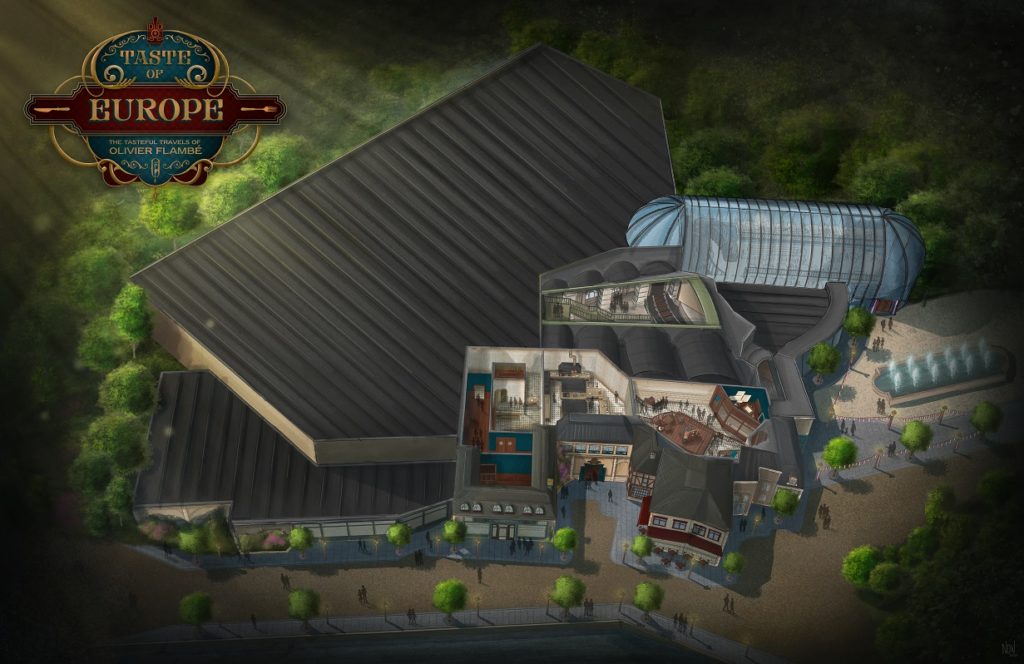
© 2021 Dark Ride Database
Interview by Erik and Luc
Article by Erik
Images provided by the design team of Taste of Europe

